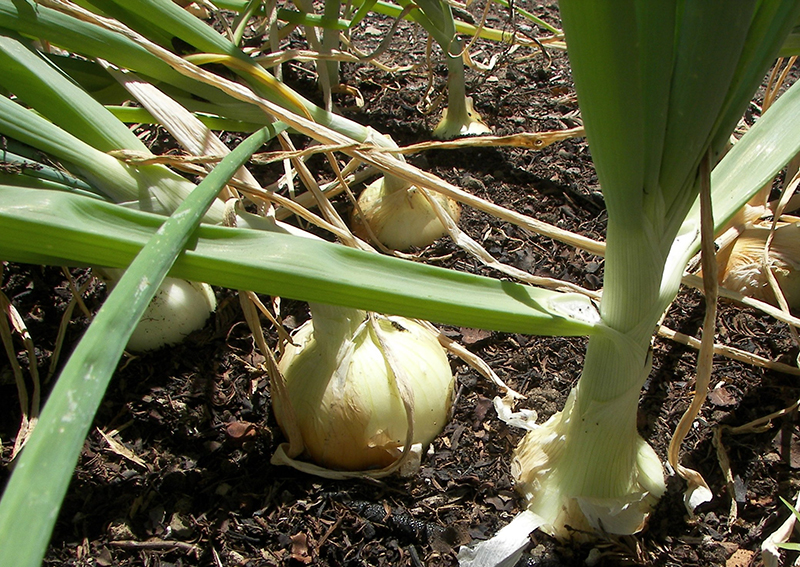by Birgitt Evans, ABG Board member and Master Gardener
It’s November and the daylight is waning. When we hit December and January, plant growth will slow dramatically as the daylight hours dip below 10. Plants need 10 hours of daylight to continue growing and on December 21st, we get about 9.5 hours of daylight. At the same time, when soil temperatures are higher than air temperatures, plants put out roots and since roots are crucial for healthy plants, overwintered plants can be stronger and more productive than those planted in the spring.
Here are five vegetables that either need to be or can be planted now for great harvests in the late winter or spring.
Garlic
October to early December is the time to plant garlic in our region. The plants put out minimal top growth in the fall, but get a great root system started so that, when we get that bright, sunny spell in early February, they are ready to go. And since each leaf equals a clove of garlic, you want big plants. Plant certified disease-free garlic purchased from a reputable supplier. There are many varieties of garlic with mild to hot flavors. The two major types are hardnecks which grow well in very cold climates and softnecks (the kind you can braid) which grow well in mild winter climates like ours. Try one of each and see which you like better.
Garlic likes fertile soil, so amend your bed or container with compost and a fertilizer that contains phosphorus. Plant individual cloves pointy end up just a little below the soil surface. Be sure to keep the bed well weeded, because garlic does not compete well with weeds. The plants will form bulbs and dry out next May or June. Harvest when mostly dried and cure in a cool, dry place for two weeks before hanging.
Onions
Onions are definitely an advanced crop, but are very rewarding to grow. A biennial, onions produce bulbs in their first year to store energy for flowering the following year. The plants are photo-periodic and are stimulated to produce bulbs by the amount of daylight around the summer solstice: long day onions produce bulbs at 14 – 16 hours of daylight, intermediate day onions at 12 – 14 hours and short day onions at 10 – 12 hours of daylight. In our region you want to plant intermediate day onions. Check the seed packet or plant label and, if it doesn’t specify, check online for the day length for that variety. Do not use sets; those are baby onions (usually long day) in their second year primed to bloom when you plant them. Onions that make flower stalks are not good for eating.
Start seeds in flats for transplant in late-January. Plants should be smaller than pencil width when planted out. Onions are heavy feeders so add compost and fertilizer at planting and supplement with a liquid fish fertilizer every few weeks until harvest. In June, the onions will begin to form bulbs. The stalks will fall over when they are ready to harvest. Cure with tops in a cool, dry place for two weeks and then remove tops and store. Most intermediate day onions will store 4 – 6 months, but check your variety.
Fava Beans
In contrast to onions, fava beans are easy to grow and will reward you with beans in late-March or April, long before most other things are producing. Fava beans are an Old World species available to ancient civilizations. Some people of Mediterranean ancestry are allergic to them, so be mindful of that if you have never eaten them before. Plant them an inch down in the soil and stake them if they start to fall over onto your other plants. They’re really that carefree. Harvest when the pods plump up and the beans are 3/4″ long. Blanch for 60 seconds and peel the outer layer off the beans and use the beans in pastas or stir fries or stews.
Peas
Who doesn’t love peas? And, like tomatoes, homegrown peas are far superior to those found in the grocery store. There are three kinds: shelling or English peas where you eat the whole pea, snap peas where you eat the fattened pod with the maturing seeds and snow peas where you eat the pod before the seeds fatten up. All are grown the same way, so it’s strictly a matter of preference. Peas are easy to grow, just push the pea ½” deep into the soil or a large container and let them cling to a tomato cage. Birds and snails love peas, so you will have to either cover them or plant them far from the bird feeder and use Sluggo if snails or slugs are a problem. Plant successive crops every two weeks for a continuous harvest.
Spinach
Spinach is a nutritious vegetable that is much more tasty when grown at home. In the summer though, it tends to bolt and can be plagued by fly larvae which burrow between the layers of the leaf, rendering it inedible. Cool season growing will solve both issues. Spinach can be hard to germinate in the ground, so start it in containers on the porch and transplant out into the garden at an inch tall. Apply Sluggo and put a row cover over it if you have a lot of birds.
Here on the edge of the San Francisco Bay, we can grow all but the fruiting crops through the fall and winter, so give these five vegetables a try and enjoy healthy, tasty winter and spring harvests.

